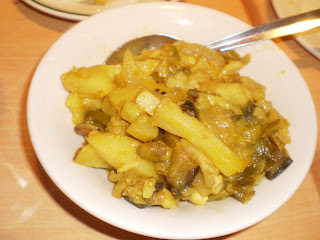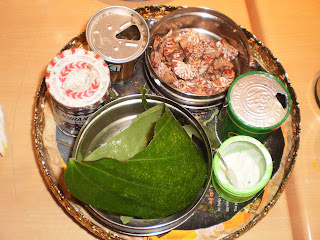

Since their arrival in the 50s, Bangladeshis have been the driving force behind an industry and and an institution that's now reckoned to be worth approximately £3.3bn a year. No high street would be complete without its 'Passage to India' or 'Jolly Rajah'. What young Englishman has not been forged by the morning fire of a vindaloo or phaal? Bangladeshis picked up where kedgeree and mulligatawny left off and introduced us to the more puissant flavours of the subcontinent.
Despite the large number of Bangladeshi owned restaurants, finding one where the food is close to 'home cooking' is difficult. There has been a real homogenisation among Britain's curry houses, whether billed as Bengali, Punjabi or Nepalese the menu in restaurants outside of predominantly Asian areas all carry the same predictable favourites, enjoyable yet largely inauthentic interpretations of dishes from the length and breadth of the subcontinent, Dopiaza (Hyderbad), Vindaloo (Goa), Rogan Josh (Kashmir) for instance. Admittedly this is starting to change a bit with more restaurateurs willing to showcase more of their native regional cooking, but you're still unlikely to find mutton brain curry.
Brick Lane was the obvious choice for this meal as the centre of London's Bangladeshi community (33.5% of the population of Tower Hamlets is Bangladeshi). Initially I was a bit snooty about the idea given my previous experiences of bartering for free pints and popadoms there and was hoping to find some unknown gem further east.
The obligatory call to the embassy for recommendations was ill received, the first person couldn't understand me, neither could the second, and the third chap seemed thoroughly vexed 'This is not our job!' Admittedly he might have had some more pressing issues on his hands, flood relief etc. but if ever I find myself working as a diplomat in Dhaka I will make it my mission to know the whereabouts of every fish and chip shop, ale tavern and chop house in the city.
The tip off eventually came from a Bangladeshi grocer's near work, in exchange for buying a jar of the formidable Mr Naga. So Brick Lane it was and Gram Bangla where the shopkeeper liked to eat once a week. Sitting down the Whitechapel end of Brick Lane, Gram Bangla is an unassuming Café which on a Saturday evening was packed with young Bangladeshi men.
Having run the gauntlet of Brick Lane's curry pushermen we were greeted with bemusement, three louts who'd accidentally stumbled into the only place that didn't serve Kingfisher, madras and peshwari naan. There are no menus but there was a fine array of curries under the chiller cabinet which they patiently explained to us. The food is specifically Sylheti, from the north eastern Sylhet region of Bangladesh where the majority of British Bangladeshis hail from. Fish is the order of the day and there's a handy poster with illustrations and the names of the myriad of Bangla seafood.
A lot of the punters seemed to be going for the thali option with meat or fish curry, a vegetable curry, daal, pickles and a sweet fritter of some sort. We went for a selection of dishes to share between the three of us, a kingfish curry with a wide flat bean pod of some sort, a lamb biryani, a potato curry with aubergine and dudhi gourd, a fish chutney, a beef curry, a dish of dried fish with drumstick and a mound of rice. According to my Bangla grocer the choice varies a lot, other weeks there might also be brain, fish roe curry or fish kofta.
Ordering the dried fish (shutki) and drumstick raised a few eyebrows, 'I rate your choice' said one of the lads on the table next to us 'try that one first'. His mates waited with bated breath for someone to take the first bite. Shutki smells like a putrid rockpool, near a sewage pipe, drying slowly on a hot afternoon. It's a challenging taste, sweet and slightly rotten with an intense savouriness, it took a few mouthfuls to get accustomed to but was delicious combined with the freshness of the drumstick (an asian vegetable similar in taste to green beans), hot fruity chili and equally pungent dried shrimp.
The fish chutney was a winner, made with dried fish again but a variety which wasn't as 'high' as the shutki with drumstick. It had been shredded and fried with both dry and fresh chilis, onions and garlic. The kingfish curry was meaty and rich, the wide flat bean which I didn't get the name of an interesting addition. The beef curry, a Bangladeshi speciality and something you rarely see even in muslim run restaurants was slighly dissappointing in it's bonyness. I'm a fan of curry with meat on the bone and the gravy was delicious, but 50% of the dish was bones without any meat on them at all and no marrow to be had.
The lamb biriani was very good, tender marinated meat which had been fried first and sealed with a crisp exterior, and fragrant 'well defined' grains of rice. The potato curry was comforting and helped soak up the heat of the other dishes. Sylhetis are renowned for their love of chilis, the naga in particular, and the food which I found sufficiently piquant was accompanied with extra chilis (both green and dried) to add to taste.
As well as being very spicy the food was pretty salty, especially the dishes with dried fish (suprising I know). I'd guess this is down to Bangladeshi tastes where a mound of rice forms the bulk of the meal and a little curry is made to go a long way. Gram Bangla which means Bangla Village certainly markets itself at Bangladeshi expats with an ad that drifts back to the paddy fields.
To finish we were offered paan (areca nut wrapped in betel leaf). An after meal tradition chewed to cleanse the palate and freshen the breath. It's also supposed to be a mild stimulant with a similar effect to caffeine. You wrap the nut in the leaf with assorted fillings, there was tobacco, sugar coated fennel seeds and caustic lime (for a burning sensation).
As a first timer I was warned off the lime. 'It will hurt you' were the sobering words of the paan keeper. Every chewer must start off with a brush of lime eventually but I feared his wrath so sent for the fennel. The leaf itself didn't taste of much, it was slightly peppery, the nut had an aniseedy/menthol flavour which relieved me of the lingering taste of 'Shutki'. Didn't feel much effect but was left with a mouthfull of woody pulp whilst I found a bin down Brick Lane. Apparently the walkways in South Asia are stained with red betel nut spittle, it's recently been banned in Dubai.
The cost of the meal was about £10 a head which was pretty good value. I was after 'authentic' Bangladeshi food and I think we certainly got a flavour of Sylheti home cooking which was far removed from my previous experiences on Brick Lane. Apparently there's a few other places similar to Gram Bangla in the area, part of recent attempts by restaurateurs to appeal to young Bangladeshi workers and students in London. I'm keen to get my face in some 'shutki' again so will definitely be back to follow my nose.
Gram Bangla, 68 Brick Lane London E1 6RL
Tel: 020 7377 6116





